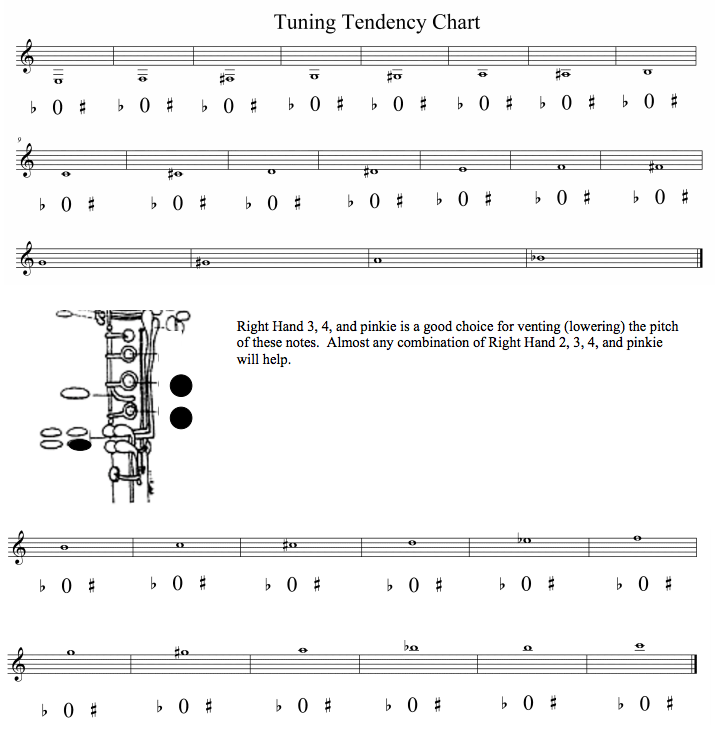Tuning Tips for Clarinet
by Paula Corley
Date Posted: May 04, 2016

Author’s Note: It is essential that clarinetists have good equipment in order to play as “in tune” as possible and blend with other wind and string instruments. This applies to everything: instrument, mouthpiece, and reeds. Mouthpieces can greatly affect pitch as can barrel length and design. Reeds may affect to a lesser degree (reeds too soft may equal ‘sagging’ pitch and loss of focus). Ligatures affect more of the tone ‘color’ rather than pitch.
Choose equipment that promotes solid intonation on the “Best Clarinet Tuning Notes” listed below. The 12th’s (chalumeau to clarion) should match between registers. For example, if the bottom note is sharp, so should the upper note.
Step One:
Warm-up your instrument. Play long, slow notes for at least 3 minutes. Begin in the chalumeau (low) register and work your way up to the clarion (middle) register.
Step Two:
Check the notes below with your tuner. Check all 4 notes before adjusting anything. Note whether you are sharp or flat on each pitch.

If you are flat, here are two possibilities:
1) your instrument is still cold;
2) there may a problem with your equipment – mouthpiece choice; barrel length.
An unfocused clarinet tone will almost always be flat. To check for focus, play on your barrel and mouthpiece first. Your barrel and mouthpiece should match a focused F# (as close as possible.)
Step Three:
Check Open G again. If you are sharp, pull the barrel out. On some instruments, pulling out to get the open G ‘in tune’ will make other notes flat. Venting (the use of extra fingers down) may need to be used on Open G (and subsequent tones G#, A, Bb) to bring the pitch down. (See tuning tendency chart.)
Concert A (your B-natural) should be pretty close to ‘in tune’ after tuning Open G. If it is still sharp, pull the bell out slightly.
The C-G 12th connection may be affected by pulling the middle joint. While some notes in the lower clarion may be affected by pulling the middle joint, others may not.
Barrel length and design affects tuning.
Most clarinetists need a 66 millimeter barrel to play in tune. A 65 will raise the tuning and a 67 will lower the tuning but are also acceptable choices. There are many custom barrel designs available that can also change the tuning of the clarinet. Purchasing a new barrel can be expensive and should be a careful process done through extensive testing with a tuner.
Mouthpieces affect tuning.
Look for mouthpieces that say American Pitch, A440, etc. Again, purchasing a mouthpiece can be complicated and requires testing with a tuner. In choosing a mouthpiece, one must also consider ‘ease of playing’ as well as tuning. If your pitch is extremely sharp, you can pull the mouthpiece out slightly. This is not recommended except in extreme cases.
Below, you will find a tuning tendency chart. It is essential to know your tuning tendencies so that you compromise with piano, other winds, and strings.
Each clarinet manufacturer builds instruments with relatively similar tuning tendencies. Most also build instruments with an ‘even scale’ meaning that the interval distance (between the notes) is accurate.
The acoustical design of the clarinet leaves very little room for pitch adjustment. Adjusting the pitch of any particular note while playing can be problematic because the embouchure must be involved. It is very easy to lose the focus of the sound if the embouchure becomes too loose. Biting the mouthpiece to try and raise the pitch may cause the sound to lose its’ ‘presence.’ Therefore, many professional players seek out master repair persons to ‘undercut’ the tone holes on the clarinet. Undercutting is a process where the shape of the tone hole is changed, which affects the pitch of individual notes. Key height can also be adjusted to assist in the tuning process.
“Bringing Down the House” (Pitch)
How do you bring down or bring up the pitch while playing passages in your music? The reality is clarinetists cannot significantly change the pitch of any given note. However, minute reductions in the amount of lip surface next to the reed and/or lip pressure may help lower the pitch slightly.
In “Advanced Intonation Technique for Clarinets/JB Linear Music” (September 19, 2006), John Gibson concludes:
“There are three basic ways to change the pitch while playing. One is to change the embouchure by firming around the mouthpiece to go higher or loosening to go lower. Remember, it is firming, not biting. Some control can be had by pushing upward or relaxing the pressure with the right hand thumb. A better route in some situations is to use alternate fingerings. An altissimo G can be fingered many ways and some may be more in tune on your instrument than the standard fingering. Also, adding fingers or opening tone holes by depressing a key can change intonation as well as resonance. Lastly, shading tone holes is a useful skill. While playing a low C, lower the right hand fingers close to the tone holes to lower the pitch…”
James Lockwood in “Pitch Adjustments in Clarinet Playing/The Journal of the Acoustical Society of America”, May 1978, Volume 63, Issue S1, page S57 states:
“Both damping and reed aperture changes may be effective in pitch adjustments made while playing…It is suggested that the single effect that dominates pitch control in a given case depends on the shape of the mouthpiece (facing)… (A closed facing)…that remains practically flat against the reed…lends itself to damping control through variation of the position and firmness of the lip. (An open facing where) there is already a significant gap at the lip position, lends itself to reed aperture control through variation of the lip pressure.”
What does all of this mean?
Basically it is easier to lower a given pitch (while playing) by moving the bottom lip first. Lockwood found that a “closed” mouthpiece responds to “damping” – (rolling more lip inside or outside the mouth). An “open” mouthpiece responds to relaxing lip pressure (without moving the lip in or out).
A “Closed” mouthpiece has very little space between the top of the reed and the mouthpiece surface. An “Open” mouthpiece has a large space between the top of the reed and the mouthpiece surface.
After warming up, check the pitch of each note with a tuner. Do this process several times over a few days for consistency. Mark each note appropriately: flat – 0 in tune – sharp.


About the Author
Paula Corley is the Education Advisor for Buffet Crampon North America. She has 33+ years of teaching experience from middle school to university level. Most recently Paula served as the clarinet instructor at Texas Lutheran University where she hosted ‘clariNETWORKS’ – a very popular annual event for clarinetists of all ages and band directors. She is also a chamber music judge for Music for All's National Chamber Music Festival and served as the Pedagogy Chair for the International Clarinet Association from 2018-2020. Most know her as the ‘mayor’ of Clarinet City, a teaching website for all ages and stages of clarinet playing.
Originally from Mississippi, Paula grew up without access to clarinet lessons which sparked a lifelong interest in research for developing players. She is a graduate of Mississippi State University (BME) where she was named Alumnus of the Year in 2012-13 and Southern Methodist University (MM) where she worked with the legendary Howard Dunn. Paula taught in Plano, Texas ISD for many years before moving to Asheville, NC where she served as principal clarinet in the Asheville Lyric Opera and on the faculty at Mars Hill University (NC).
Author of So You Want to Play the Clarinet and The Break (Southern/Hal Leonard), Paula has performed and presented at music conferences throughout the US since 1998. She is a performing artist and clinician for Vandoren and for Buffet Crampon and her articles have appeared in THE CLARINET, Vandoren WAVE, The Texas Bandmasters Review, and The Instrumentalist. A new series of her arrangements for clarinet can be found at Hal Leonard. She also has two recorded works for clarinet: Unfamiliar Territory by Michael Markowski and Road Trip for clarinet quintet by Clifton Jones. Visit clarinetcity.com.
Subscribe to the We Are Vandoren E-newsletter (WAVE) to receive 4 weekly articles for Performers, Students, and Educators